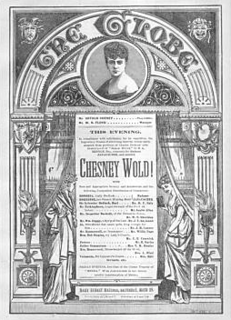Related Research Articles

This section of the Timeline of United States history concerns events from 1860 to 1899.

Constance Fenimore Woolson was an American novelist, poet, and short story writer. She was a grandniece of James Fenimore Cooper, and is best known for fictions about the Great Lakes region, the American South, and American expatriates in Europe.

More than 1,500 African American officeholders served during the Reconstruction era (1865–1877) after passage of the Reconstruction Acts in 1867 and 1868 as well as in the years after Reconstruction before white supremacy, disenfranchisement, and the Democratic Party fully reasserted control in Southern states. Historian Canter Brown, Jr. noted that in some states, such as Florida, the highest number of African Americans were elected or appointed to offices after 1877 and the end of Reconstruction. The following is a partial list some of the most notable of the officeholders pre–1900.
Alexandra Athletic Football Club was a 19th-century football club from Dennistoun, in Glasgow, which participated in the early years of the Scottish Cup.

The Globe Theatre (est.1871) was a playhouse in Boston, Massachusetts, in the 19th century. It was located at 598 Washington Street, near the corner of Essex Street. Arthur Cheney oversaw the Globe until 1876. From 1871-1873 it occupied the former theatre of John H. Selwyn. After a fire in May 1873, the Globe re-opened on the same site in December 1874. Architect Benjamin F. Dwight designed the new building. From 1877-1893 John Stetson served as proprietor; some regarded him as "a theatrical producer with a reputation for illiteracy in his day such as Samuel Goldwyn has achieved" in the 1960s. The theatre burned down in January 1894.
References
- ↑ Glasgow Herald 17 December 1869
- ↑ Glasgow Herald 20 December 1869
- ↑ Glasgow Herald 20 December 1869
- ↑ The York Herald 20 December 1873
- ↑ Glasgow Herald 26 February 1875
- ↑ The Newcastle Courant 8 December 1876
- ↑ The Newcastle Courant 7 December 1877
- ↑ The Newcastle Courant 6 December 1878
- ↑ The Newcastle Courant 2 March 1883
- ↑ Birmingham Daily Post 6 December 1888
- ↑ The Standard 5 December 1889
- ↑ Glasgow Herald 20 December 1869
- ↑ Glasgow Herald 20 December 1869
- ↑ The York Herald 20 December 1873
- ↑ Glasgow Herald 26 February 1875
- ↑ The Newcastle Courant 8 December 1876
- ↑ The Newcastle Courant 7 December 1877
- ↑ The Newcastle Courant 6 December 1878
- ↑ The Newcastle Courant 2 March 1883
- ↑ Birmingham Daily Post 6 December 1888
- ↑ The Standard 5 December 1889
- ↑ The York Herald 20 December 1873
- ↑ The Newcastle Courant 8 December 1876
- ↑ The Newcastle Courant 6 December 1878
- ↑ Birmingham Daily Post 6 December 1888
- ↑ The Newcastle Courant 6 December 1878
- ↑ The Standard 6 December 1888
- ↑ The Newcastle Courant 2 March 1883